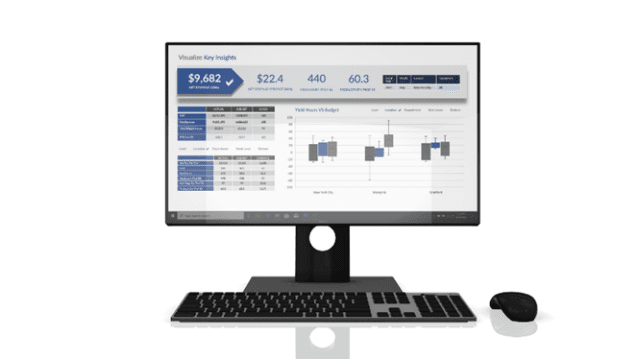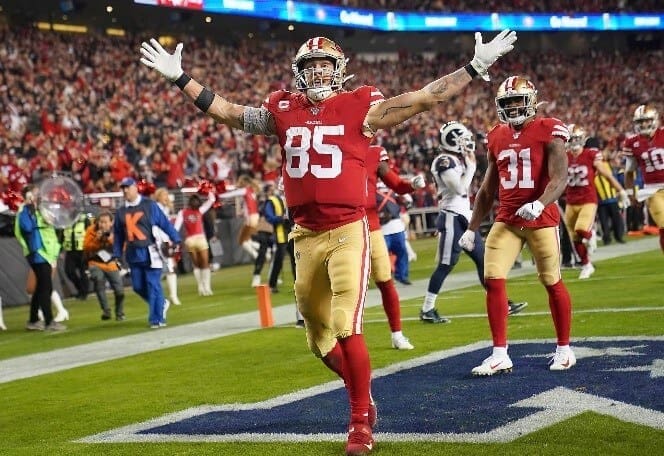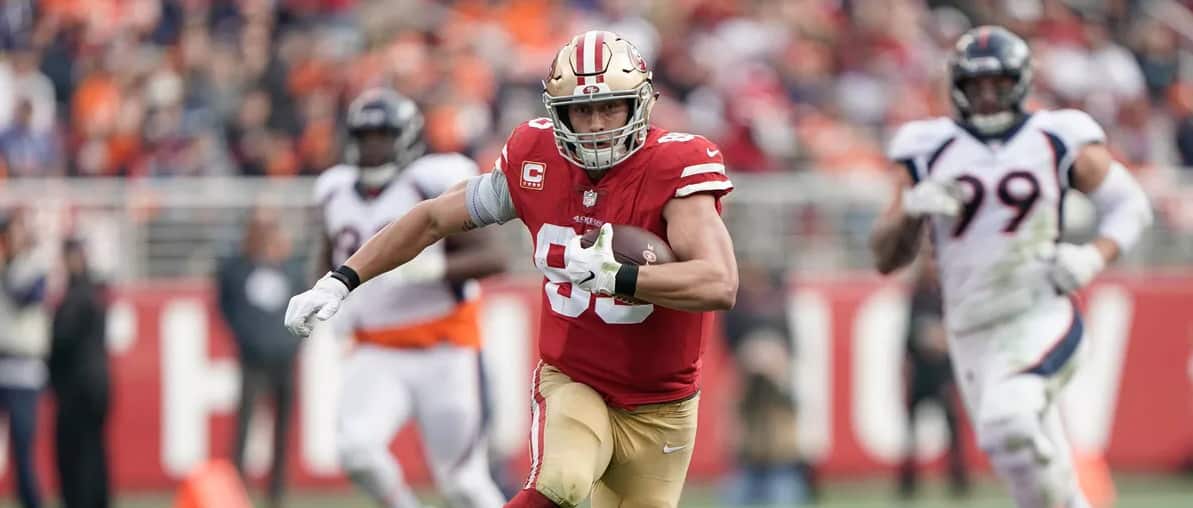“Blue 42, Blue 42, 54 is the Mike, Omaha, set, hut!”. This or a similar cadence can often be heard by a quarterback “calling the signals” during an NFL football game. What’s this all about? To most of us it is unintelligible but to the players on the field it provides essential information. It can be used to set a cadence for the offense or as a tactic to confuse the defense. Each word or phrase called out by the quarterback is scripted to communicate the play to the offense or to communicate the defensive set.
This is just one of the many ways signals are used in football. While remembering the play called in the huddle and listening to the signals the quarterback communicates at the line of scrimmage, the players on the field are also reading specific signals in the defense that will influence how they are going to execute the play.
A good example of a player who is constantly reading signals in the defense and adjusting his execution is George Kittle, of the San Francisco 49ers. OneStream Software had the pleasure of hosting a webinar featuring the All-Pro tight end where we discussed his techniques for reading defenses – and compared it to the way finance executives can read the signals in their business in order to make mid-stream adjustments in order to optimize performance. In case you missed it, here’s a link to the replay and below are some of the highlights of the discussion.
Reading Signals in Your Business
OneStream President Craig Colby kicked off the webinar with a brief introduction to OneStream and our unified Intelligent Finance platform. Because the OneStream platform unifies financial close and consolidation, planning, reporting and analysis in a single application it brings several benefits to organizations. OneStream customers are able to:
- Shorten period-end close processes
- Deliver more timely and accurate financial results to stakeholders
- Improve insights into financial and operational results with advanced analytics
- Streamline budgeting and forecasting, gain agility in planning
- Reduce cost of ownership by eliminating multiple legacy CPM applications
- Easily extend the platform for new requirements and technology innovation
The OneStream XF MarketPlace enables customers to extend their investment in the platform with over 50 solutions they can download, configure and deploy to address additional requirements without adding complexity. This includes solutions like Account Reconciliations, Tax Provision, Lease Accounting, People Planning, Capital Planning and more.
But new customer requirements are emerging. To be a more strategic advisor to business partners, finance teams need to not only master month end close, reporting and planning – they also need the time, insight and foresight to take action now that will impact financial results in the current period and future periods. If they can accomplish this, they can deliver more tangible business value.

And to do that – they need a way to decipher the financial signals hidden in detailed weekly and daily operational data, such as customer billings and collections or supplier performance. Having insights into this data allows them to work with their business partners to take action now that will impact period-end financial results BEFORE the end of the month or quarter.
Making these mid-game adjustments in business is similar to what happens in professional football as teams and players continually make changes to their game plan in order to outsmart the opposition and win the game. And no one does this better than George Kittle.
Reading Signals in Football
George Kittle is a tight end for the San Francisco 49ers of the National Football League (NFL). He played college football for the University of Iowa Hawkeyes and was drafted by the 49ers in the fifth round of the 2017 NFL Draft. He is a two-time Pro Bowler and a First-team All-Pro selection. In 2018, Kittle set the single season record for receiving yards by a tight end, with 1,377.
In a short time in the pros, Mr. Kittle has become one of the best players in the league, the only disappointment being his team’s loss to the Kansas City Chiefs in Super Bowl LIV, back in February 2020. But shortly after the game Mr. Kittle vowed to return to the Super Bowl with a vengeance.
Roll the Video

During the webinar, we ran video of several successful plays featuring Mr. Kittle and asked him to comment on what he was seeing before the play and then what happened during the play to make it successful. For example, he spoke about how he’s reading the position of the defensive safeties and linebackers in deciding which route he’s going to take on a passing play. He also spoke about how the offensive team will use motion in their formation before the snap to detect whether the defense is set up in man-to-man or zone formation. He also highlighted how in some cases a mis-que by the offense can turn into an improvised play that can still be successful.
This was a fascinating discussion featuring several key touchdowns featuring Mr. Kittle, as well as several long-gaining pass plays. In the course of the conversation and in the Q&A session that followed, Mr. Kittle revealed several best practices that have led to his success and the success of his team, which also have applicability in finance and business. This includes the following:
- Master the game plan – Hone repeatable processes to the point that they are virtually automatic. Complete confidence in your ability to execute the core components of the game plan frees up your mind to focus on reading the signals at the line of scrimmage and making the adjustment that turns the play from a 5-yard gain to an 80-yard touchdown.
- Give it your all. Knowing you’ve put in the work to be the best you can be gives you the confidence to perform under pressure. See this link to a short video ESPN aired on Father’s Day about the inspiring letters George’s father sends him before every game.
- Establish a consistent routine that’s the same every week and stick with it: e.g., Monday ice, Tuesday yoga, Wednesday game planning, Thursday and Friday practice plays. An established routine allows you to relax your mind and body so you’re ready to “ball out” on game day.
- Make others on your team successful – Kittle was known for his outstanding blocking at the University of Iowa and is now regarded as one of the best blocking tight-ends in the NFL. He takes great pride in delivering the perfect “pancake block” to free up one of his teammates for a long run.
- Learn from mentors/idols – Mr. Kittle mentioned how he has studied and mimics the best practices of many other great tight ends like Dallas Clark, Jason Witten, Rob Gronkowski and others.
- Make mid-game adjustments – this happens on every play, use input from coaches, your teammates and your own knowledge of the game and the situation to make the right adjustment at the right time.
- Leverage analytics – every team has statistics; these can be useful in predicting what the opposing team will do in certain situations like 3rd down and 1 yard to go. George believes the key to analytics in football is using the the detailed analytics provided by the coaches to develop a game plan that best takes advantage of the skills and football acumen of the players who will execute on that plan.
- Visualize success in advance – putting in the work to be as prepared as is humanly possible is part of George’s routine but he supplements that with visualizing the desired outcome of plays so that his mind and body have already “experienced” the successful outcome.
Learn More
All of these best practices and habits highlighted by Mr. Kittle are also applicable in business. I thought mastering the game plan and “visualizing success” were especially applicable for finance executives. The more you can automate the core finance processes the more time you’ll have to focus identifying and acting on the financial signals in your business. Visualization can be effective in advance of key board or investor presentations to anticipate their questions and practice your answers in advance to ensure success. To learn more, watch the replay of this webinar and contact OneStream if you need help analyzing the signals in your business that can help optimize decision-making and improve business performance.
Get Started With a Personal Demo



